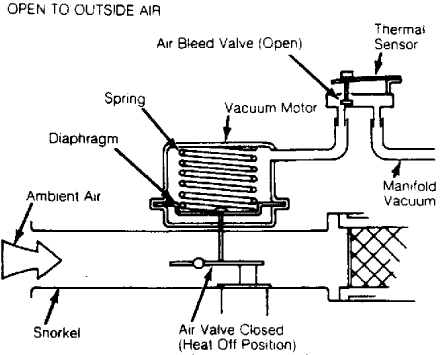AIR CLEANER - THERMOSTATIC
1988 Jeep Cherokee
1988 Exhaust Emission Systems
JEEP THERMOSTATIC AIR CLEANER
DESCRIPTION
On models equipped with carburetor, a system for pre-heating
air entering carburetor is used. This system is part of the air
cleaner and maintains air temperature at a point where carburetor can
be calibrated at leaner setting to reduce hydrocarbon emissions and
improve driveability during warm-up.
These systems are vacuum-operated and consist of heat shroud
on exhaust manifold, hot air duct, thermal sensor switch, vacuum
motor, air valve assembly and reverse delay valve.

Fig. 1: Thermostatic Air Cleaner (TAC) Assembly
Courtesy of Chrysler Motors.
OPERATION
During engine warm-up, temperature sensor switch applies
vacuum to vacuum motor. Air diverter valve is held to "ON" position.
Exhaust manifold heated air flows to air cleaner. As temperature of
incoming air increases to 90
vacuum line to atmosphere allowing spring pressure to push valve to
"OFF" position. Air now flows from outside, through air cleaner duct
to carburetor.
o F (32 o C), temperature sensor opensAIR CLEANER TRAP DOOR
On California vehicles, spring-loaded trap door is built
into air cleaner to close off air cleaner when engine is shut off.
Door is vacuum operated.
REVERSE DELAY VALVE
Reverse delay valve is installed in vacuum line in some
vehicles to prevent trap door from closing during low engine vacuum
periods. Valve provides about 9 seconds delay before allowing trap
door to close.

Fig. 2: Cutaway View of Thermostatic Air Cleaner Assembly
Courtesy of Chrysler Motors.
TESTING
VACUUM MOTOR & TEMPERATURE SENSOR
1) Remove air cleaner assembly from vehicle and allow to
cool to room temperature. Look through air cleaner duct and observe
position of air diverter valve. It should be fully open to outside
air.
2) Reinstall assembly on carburetor and connect hot air duct
and manifold vacuum hose. Start engine and observe position of air
valve in snorkel. It should be fully closed to outside air.
3) Move throttle lever rapidly to 1/2 to 3/4 opening and
release. Air diverter valve should open and then close again. Allow
engine to warm to operating temperature and observe position of air
valve in snorkel. It should be fully open to outside air.
4) If valve does not move to fully close off outside air at
83
vacuum leaks in hose connections or disconnected vacuum motor. If
valve mechanism operates freely and no vacuum leaks are detected,
connect hose from intake manifold vacuum source directly to vacuum
motor.
5) If air valve now moves to close off outside air, replace
thermal sensor switch. If valve still does not move to close off
outside air, replace air cleaner assembly and vacuum motor assembly.
o F (28 o C) or less with vacuum applied, check for binding of duct,TRAP DOOR
1) With engine off, remove air cleaner and check position of
trap door. It should be closed.
2) Remove vacuum hose from intake manifold vacuum source and
apply an external vacuum source of approximately 2-4 in. Hg vacuum.
Trap door should open.
3) If door does not open, apply vacuum directly to vacuum
motor. If door does not open, check for binding and adjust as
necessary. If door swings freely, replace vacuum motor.
4) If door opens during step 3), check vacuum hose for
blockage, cracks or leaks. Correct as necessary and retest as
specified in step 2).
5) If hoses are not defective, remove reverse delay valve,
join vacuum hose and retest from step 2). If door opens, replace
reverse delay valve.
REVERSE DELAY VALVE
1) Connect external vacuum source to port on White side of
delay valve. Connect one end of 24" (610 mm) section of rubber hose
to vacuum gauge and other end to port on colored side of valve.
2) With a constant 10 in. Hg vacuum applied, note time
required for vacuum gauge pointer to move from 0-8 in. Hg.